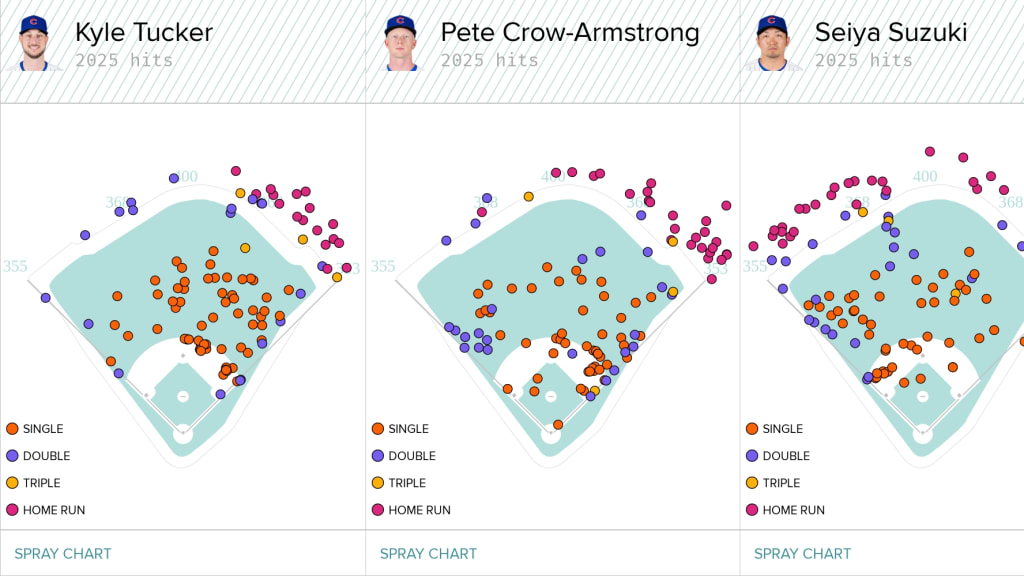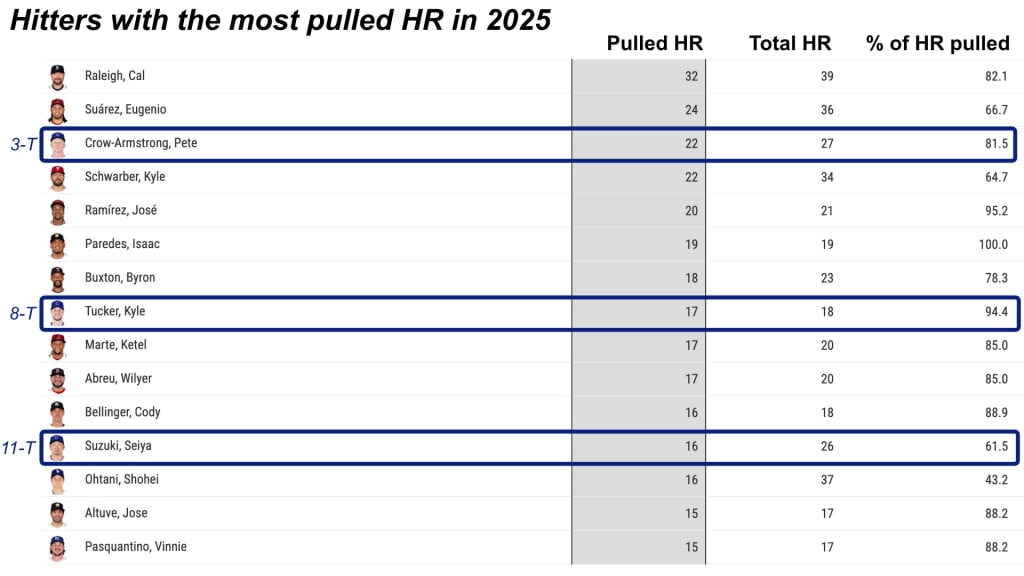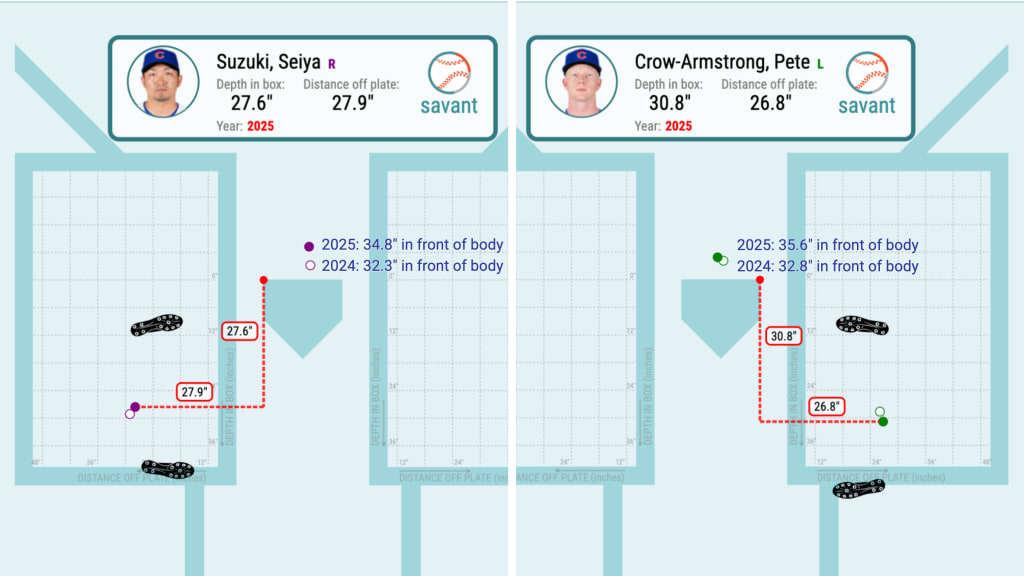This story was excerpted from Jordan Bastian’s Cubs Beat newsletter, with David Adler filling in for this edition. To read the full newsletter, click here. And subscribe to get it regularly in your inbox.
By now, every Major League team knows it: The easiest way to slug is to hit the ball out in front and pull the ball in the air.
But you still need the players to do it. You need the hitters with the skill to drive the ball in the air, and the mindset to buy into that approach. And in 2025, one team stands out.
The Cubs have built a pulled airball machine. And they've become one of the best teams in the National League in the process.
"It's not something we identified as a team and said, 'Hey, as a team, we are going to pull balls in the air.' That wasn't a message I gave in Spring Training," hitting coach Dustin Kelly said. "[But] we have the personnel that has the ability to do it."
Last season, the Cubs ranked 22nd in the Major Leagues in pulled air contact. Only 16.8% of their batted balls were pulled in the air. This season, they rank first.
Teams with the highest pulled airball % in 2025
All stats entering play Thursday
- Cubs: 21.3%
- Guardians: 21.2%
- Tigers: 20.1%
- Royals: 19.8%
- Dodgers: 19.6%
- Astros: 19.6%
The Cubs' three star sluggers are leading the way: Kyle Tucker, Pete Crow-Armstrong and Seiya Suzuki. Tucker has been pulling balls in the air his whole life. But PCA and Suzuki have made adjustments to tap into their pull power this season.

The vast majority of the damage is to the pull side. Look at the home runs, especially. Tucker, PCA and Suzuki all rank in the top 15 in the Majors in pulled homers this season.

It's not just that trio, though. The whole Chicago lineup is assembled to slug fly balls. Hitters like Michael Busch, Carson Kelly and Ian Happ all do it, too. And the Cubs even acquired a veteran leader who was at the vanguard of the launch angle revolution: Justin Turner.
Though Turner doesn't turn on pitches and sky home runs quite so often as he used to, he's one of the most knowledgeable hitters in baseball -- and an air contact guru. When Turner arrived in Chicago this season, he saw a team focused on optimizing its offensive approach.
"I think it's been ingrained here," Turner said of the Cubs' penchant for driving the ball in the air. "It wasn't something, by any means, that I came in and said, 'Hey, you guys are doing it all wrong, you've got to do this,' and now all of a sudden it's happening. It's just, I think guys are coming into their own. And they're understanding what damage looks like."
The benefits of Chicago's hitting style are obvious. Pulled fly balls and line drives are the quickest pathway to home runs and extra-base hits. The Cubs are tied for the NL lead with a .446 team slugging percentage, rank second to the Dodgers with 152 homers and rank second to the D-backs with 345 extra-base hits.
"Just, overall, production is better in the air," Kelly said (that's still Dustin the hitting coach, not Carson the catcher). "And I think nowadays everybody knows that. You can't trick 'em. You can't trick [hitters] and say, 'Hey, you've got to stay on the ground here because you're fast, you're going to get more hits.' No. They see the reports just like we do -- when they hit the ball high and hard, it's usually good results."
Even for a speedster like Crow-Armstrong, that holds true. PCA's leap to stardom this season has been driven by his power surge -- he's always had the elite speed and defense, but the 27-home-run power is new. And it's all to the pull side.
"I think it's a contact point thing," Crow-Armstrong said. "I'm just playing the game out front. Simplified some things in the swing. So I would probably just say [it's because of] that."
PCA moved back in the batter's box to see pitches a little longer, switched to a bigger bat, and is now unloading. Being able to elevate the ball to the pull side, Kelly said, is a byproduct of Crow-Armstrong's swing being in a better place. Over 28% of his batted balls this season are pulled in the air, which puts him in the top tier of MLB hitters. Last season, that number was under 20%.
"As I've gotten better every year, I've started to use my body better to put the ball in the air," Crow-Armstrong said. "I've always had a little bit of lift in my swing. I'm just taking advantage of that more this year."
He's had one of the biggest jumps in pulled air contact of any big league hitter. The biggest? That belongs to his teammate, Suzuki, who now pulls the ball in the air almost as often as PCA, a stark contrast to his first three seasons in Chicago.
Largest increases in pulled airball %, 2024 to 2025
- Seiya Suzuki: +11.0 percentage points (15.2% to 26.2%)
- Alex Bregman: +10.4 points
- Cal Raleigh: +9.0 points
- Pete Crow-Armstrong: +8.8 points (19.3% to 28.1%)
- Ryan McMahon: +7.7 points
For both hitters, the boost in contact quality is driven by a change in contact point. Both Suzuki and Crow-Armstrong are hitting the ball much farther out in front of their own body, which allows them to reach higher bat speeds and drive the ball in the air to the pull field.
Suzuki and PCA's contact point change, 2024 to 2025
Relative to batter's center of mass
- Suzuki: +2.5 inches farther out in front (32.3 inches in front of center of mass in 2024 to 34.8 inches in 2025)
- PCA: +2.8 inches farther out in front (32.8 inches in front of center of mass in 2024 to 35.6 inches in 2025)

But while PCA made some mechanical changes that translated to a new contact point, Suzuki's have been more mental.
"We've shown him over the years that when he hits the ball in the air, his numbers are much better," Kelly said. "With Seiya, there was a lot more of, 'Hey, you're gonna get your swing off earlier. You're gonna be more aggressive in the zone. You're looking to do damage to the pull side in the air.' And we're seeing that happen."
Getting to watch Tucker hit in Chicago this year, Kelly said, has been a positive influence on Suzuki and his own slugging. Tucker has been an elite pull-power hitter since he first broke out with the Astros.
"Tucker? Tucker's Tucker," Kelly said. "We haven't touched any of his approach."
The Cubs don't need to. In each of Tucker's four consecutive All-Star seasons from 2022 to 2025, he's boasted a pulled airball rate well over 20%. This year, he's at 25.6%. His hitting technique has translated perfectly from Houston to Chicago.
"Some guys probably just naturally do it more than others," Tucker said. "I just try to have a good point of contact. If you have a good swing direction and sense of what you want to do at the plate, it puts you in a better position to do stuff like that. I don't try to force it or anything. … I just try to catch the ball a little bit out in front, hit it hard in the air and stay through it."
Adding a hitter of Tucker's caliber -- but just as importantly, adding a hitter with a consistent approach that gels with the team's goals -- has trickledown effects for the lineup.
So does having Turner in the clubhouse as a fount of hitting knowledge.
"What J.T. has brought is just approach, and wisdom, and expertise," Kelly said. "He's not advocating for guys to change their swings; he's not advocating for guys to hit the ball in the air. But when he's talking through approach -- 'OK, here's what I would be looking to do against this guy' -- a lot of the time it is, 'Hey, we're gonna get [the pitch] a little bit closer to us, and maybe a little bit more up,' or, 'We're gonna see this guy a little bit down, but we're gonna try to stay underneath the baseball.' Those conversations happen.
"He thinks about it from a lens of how he hits, and that's kind of his style. He's pulled the ball in the air for a long time and been really successful doing it."
Turner famously reinvented his swing to launch fly balls when he signed on with the Dodgers before the 2014 season, then quickly blossomed into a star hitter. In the decade of the Statcast era, he has one of the highest airball rates of any Major League hitter.
Now, with Turner on the Cubs, PCA in particular has picked the 17-year veteran's brain about how to make the best contact he can.
"I would say I talk to J.T. a little bit more about hitting than Kyle," Crow-Armstrong said. "Kyle's just so unique -- and really [freaking] good, obviously. But J.T. and I talk about the moves [in my swing] and everything."
Turner explained: "I just think with his swing, he already has the natural ability to lift. So for him to go in and try to lift is probably a disservice. So we just talk about being on time, establishing his contact point, and then keeping his direction going forward."
Tucker had teammates like that himself in Houston in Jose Altuve and Alex Bregman, who were the Astros' cornerstone stars when Tucker came up -- and happen to be two of the most extreme, and prolific, pull-power hitters in the league. But Tucker doesn't hunt pulled contact. He hunts hard line drives, and the pull power comes from that. That's what he learned from his fellow Astros.
"With them, it was more mindset and approach stuff that I took -- not necessarily just trying to pull balls in the Crawford Boxes and hit homers," Tucker said. "If you're just trying to drive the ball, you'll start catching stuff out in front. It's not about, like, 'Lift and get under it.' You'll just naturally start hitting the ball in the air, and hitting it hard."
Tucker has hit two-thirds of his batted balls in the air over his four-year All-Star run. He's figured it out. Now he and Turner can both lead by example in Chicago.
"My thing is, I'm not trying to hit any balls on the ground. Infielders are way too good at their positions that most of those aren't going to get through," Tucker said. "That's the thing: If you're hitting hard line drives, you're gonna probably get under a few balls and they're just going to go naturally and carry out of the park."
